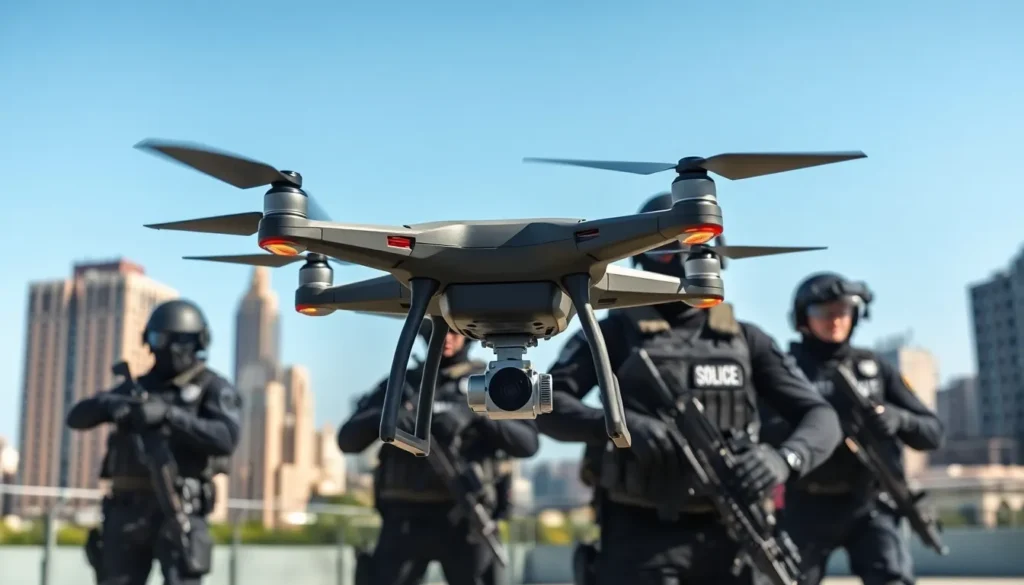In a world where drones have taken to the skies, helicopter drones are the high-flying superheroes of the tech realm. They combine the agility of traditional helicopters with the cutting-edge technology of drones, making them the ultimate gadget for thrill-seekers and professionals alike. Imagine zipping through the air, capturing stunning aerial footage, or surveying landscapes with the grace of a bird – all without breaking a sweat.
Table of Contents
ToggleOverview of Helicopter Drones
Helicopter drones integrate the agility of traditional helicopters with innovative drone technology. Operators appreciate how these drones provide enhanced stability and control, making them ideal for various applications. In commercial settings, they excel in aerial photography, film production, and landscape surveying.
Engineers have designed these drones to feature multi-rotor systems, which allow for vertical takeoff and landing. This capability enhances accessibility in diverse environments, including urban areas and rugged terrains. Users can benefit from features such as real-time video transmission, GPS tracking, and automated flight paths, significantly improving operational efficiency.
Many helicopter drones come equipped with advanced sensors. Such sensors include thermal cameras and LiDAR, expanding their utility in industries like agriculture and emergency response. In agriculture, farmers utilize them for crop monitoring and precision farming. Emergency responders rely on their aerial perspective for search and rescue missions.
The increasing popularity of helicopter drones is reflected in market growth rates. According to industry reports, the global drone market is projected to reach $42.8 billion by 2025, with significant contributions from helicopter drone technology. This upward trend indicates not just a shift in recreational usage but also a strong demand in sectors like infrastructure inspection and logistics.
Adopters of helicopter drones remain excited about their potential for future developments. Ongoing advancements in battery technology promise longer flight durations, enhancing the practical applications of these versatile devices. As technology evolves, helicopter drones may redefine aerial operations across various industries, pushing the boundaries of what is achievable.
Types of Helicopter Drones
Helicopter drones come in various types, each designed for specific applications and environments.
Multi-Rotor Drones
Multi-rotor drones feature multiple rotors, typically four to eight, providing enhanced stability and control during flight. They excel in capturing high-quality aerial footage due to their forgiving nature and agility. Users appreciate these drones for vertical takeoff and landing capabilities, making them suitable for confined spaces. Many multi-rotor models include advanced features such as GPS and automated flight paths, which streamline operations and reduce pilot workload. Their versatility makes them popular in industries like film production, agriculture, and inspections.
Single-Rotor Drones
Single-rotor drones utilize one large rotor and a tail rotor, resembling traditional helicopters. This design allows them to achieve longer flight times compared to multi-rotor alternatives. Significant lifting capabilities make single-rotor drones ideal for carrying heavier payloads, including sophisticated sensors and cameras. Stability during high winds adds to their effectiveness in outdoor environments. Operators favor these drones for surveying, mapping projects, and emergency response situations, where durability and endurance are essential.
Applications of Helicopter Drones
Helicopter drones serve various purposes across multiple fields. Their versatility attracts many users seeking efficiency and unique capabilities.
Commercial Uses
Commercial sectors widely adopt helicopter drones for tasks like aerial photography, surveying, and inspections. Aerial footage enhances marketing campaigns for real estate and tourism industries. Moreover, construction firms utilize these drones to monitor large sites and assess progress. Energy companies depend on drones for inspecting power lines and wind turbines, improving safety and reducing costs. Agricultural applications include crop monitoring and precise pesticide distribution, enhancing yield and sustainability. The demand for these services contributes to the projected $42.8 billion market growth by 2025. Businesses increasingly rely on helicopter drones to streamline operations and gather valuable data.
Recreational Uses
Recreational users find helicopter drones exciting for hobbyist flying and creative photography. Enthusiasts enjoy the thrill of piloting drones in diverse environments, capturing stunning images from unique perspectives. Events like drone racing offer competitive fun, attracting growing audiences and participants. Some users customize their drones for personalized experiences, enhancing functionality with advanced sensors or improved cameras. The rise of social media encourages sharing aerial content, fostering a community of drone lovers who inspire one another with innovative shots. Overall, helicopter drones provide an engaging mix of adventure and creativity for recreational users.
Advantages of Helicopter Drones
Helicopter drones offer significant advantages in various fields. Enhanced maneuverability characterizes their design, allowing users to navigate complex environments easily. Advanced sensors integrated into these drones improve data collection, making applications in agriculture and emergency response more effective.
Real-time video transmission provides immediate insights, facilitating timely decision-making for professionals. Greater flight times are achievable with single-rotor models, which are perfect for extensive surveying tasks and carrying heavier payloads. Multi-rotor drones excel in stability, particularly in confined spaces, making them ideal for cinematic applications and detailed inspections.
Users benefit from seamless GPS tracking, guiding flights with precision and reliability. Cost-efficiency in operations becomes apparent when employing helicopter drones for infrastructure inspection and logistics. Agricultural practices also improve through precise crop monitoring, paving the way for sustainable yield enhancements.
In recreational settings, helicopter drones engage hobbyists and encourage creativity in photography. Opportunities for customization allow users to tailor their drones for specific needs, expanding their functionality. Drone racing events further cultivate a community where enthusiasts share and showcase innovative aerial content.
Market growth reflects the increasing popularity of helicopter drones, with the global drone market projected to reach $42.8 billion by 2025. Industries such as real estate and tourism integrate helicopter drones into their marketing strategies for stunning visual appeal. Diverse applications highlight the transformative potential of this technology across sectors, enhancing efficiency, safety, and overall user experience.
Challenges and Limitations
Helicopter drones face several challenges impacting their functionality and applicability. Weight limitations restrict payload capacity, affecting the type of equipment users can carry. Battery life often constrains flight time, with many models averaging 20 to 30 minutes per charge. Environmental factors add another layer of complexity; wind and rain can hinder stability and performance during operations.
Maintenance requirements necessitate regular check-ups to ensure optimal functioning, which can be time-consuming and costly for users. Regulation adherence presents further challenges. Operators must navigate complex rules set by aviation authorities for flight permissions and airspace restrictions. These regulations vary by region, necessitating thorough knowledge to operate legally.
Weather conditions heavily influence operational capabilities. Flying in adverse weather can result in damaged equipment and loss of control. Additionally, limited range can restrict the effective operational area, particularly for remote locations where real-time data transmission is critical.
Technical issues can arise with advanced features, such as sensor malfunctions. A failure in the GPS component can disrupt navigation and data accuracy, posing significant risks. The initial investment cost for high-quality helicopter drones might deter some potential users, despite the long-term savings in operational efficiency and versatility.
Integration challenges with existing systems can also inhibit widespread adoption in certain industries. Compatibility with traditional equipment and workflows requires careful consideration. Ultimately, addressing these challenges is crucial for realizing the full potential of helicopter drones in various sectors.
Helicopter drones represent a significant advancement in aerial technology. Their unique combination of agility and advanced features makes them invaluable across various industries. From enhancing safety in construction to revolutionizing agricultural practices, these drones are changing the way tasks are performed.
As the market continues to grow, the potential for helicopter drones to impact both professional and recreational fields is immense. With ongoing innovations in battery life and sensor technology, users can expect even greater capabilities in the future. Embracing this technology will not only improve operational efficiency but also foster creativity and community among enthusiasts. The future of helicopter drones is bright and full of possibilities.





